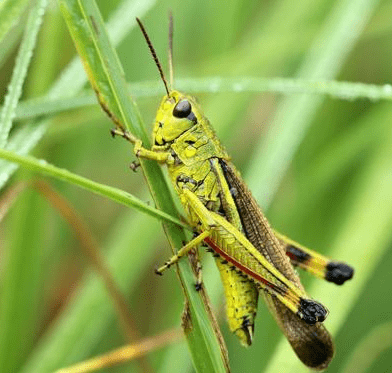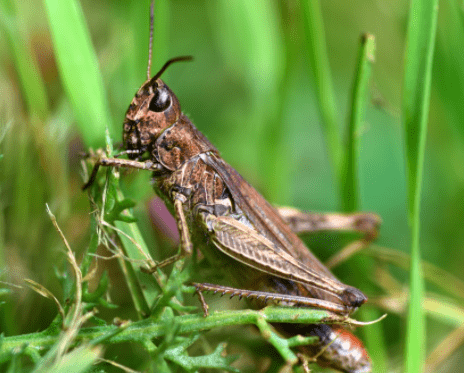Grasshoppers are popular insects in lawns and gardens. While they appear beautiful as they jump from one place to another, grasshoppers can become destructive to your lawn grasses and other crops in your garden especially when they form swarms. So, do grasshoppers bite?
The answer is no, grasshoppers don’t bite humans. They may bite when provoked or feel threatened but the bite isn’t usually poisonous or dangerous. Any pain caused by their strong jaws usually disappears without any medical intervention.
Grasshoppers feed and nest on lawn grasses, flowers, and other low-growing garden plants. These insects prefer to live in dry conditions and when wet or cold weather sets it, you are likely to find them inside your home.
What do Grasshoppers Eat?

In most cases, grasshoppers aren’t particular about what they dine on but they prefer green leaves. These include lawn grasses, green vegetables, and food crops.
When plant supplies are scarce, they can also eat fungi such as mushrooms and other weak insects.
Some types of grasshoppers such as locusts are serious agricultural pests. In large swarms, they can destroy thousands of acres of food crops. They are part of the reasons for food shortages in some countries in Asia and Africa.
Do Grasshoppers Bite?
Grasshoppers are harmless and they do not bite humans. Some types of grasshoppers can only bite when they get agitated. Although not poisonous, their bite can feel painful. However, you do not have to worry when a grasshopper bite you, sometimes you may not notice.
But in the event that you are walking in your garden and something bites you, also inspect for lawn spiders. Clean the affected area with soap and water and if there is any swelling, apply a cold compress. Seek medical attention if pain persists for over a week.
Since biting is not a common defense mechanism in grasshoppers, they usually spit out a brown liquid when they feel threatened. This defensive regurgitation is also known as “tobacco spit”, but it does not contain any tobacco. The spit is typically digested materials and enzymes but it’s not harmful to humans as well.
Large grasshoppers such as locusts have strong spiked hind legs. When you catch one, it may kick and dig spikes into your skin. This can cause minor skin injuries or irritation although not dangerous as well.
Identification
Grasshoppers come in a variety of species with different body sizes and colors. They are found everywhere in the world except the Antarctic where it’s too cold. As the name suggests, they love staying in grassy areas although you can also find them in forests and jungles.
Female grasshoppers lay eggs in the soil covered with vegetation. The eggs hatch during the spring and mature into adults during summer which lays eggs again. Most species are solitary while others such as locusts live in large swarms.
When conditions are unfavorable, these insects will migrate in search of greener pastures, and in the process, they end up invading farms and gardens. Significant damage can be noticed on vegetables, fruits, flowers, trees, and grasses.
Difference between grasshopper and locust

Locust is a type of grasshopper with stronger and longer wings that makes them have strong powers of flight.
Unlike grasshoppers, locust swarms fly over a long distance in search of food. Both herbivorous insects will cause severe damage to crops and vegetation when they invade a field.
Locust swarms can contain millions of individuals and their arrival in a region leads to devastating impacts on crops, pasture, and fodder. Currently and throughout history, locust plagues have led to food insecurity and famines that have affected millions of families across the globe.
According to a report by worldbank.org, a small swarm (1 km2) can be made up of 80 million locusts which are capable of consuming the same amount of food in one day as 35,000 people, while a large swarm can eat up to 1.8 million metric tons of green vegetation, equivalent to food enough to feed 81 million people.
Difference between grasshopper and cricket
Crickets and grasshoppers are insects in the same family but with different behavioral features. Both are great jumpers found in lawns and gardens and they can feed on plants and animal matter. Crickets are smaller in size and known for their chirping noise in the fields.
While grasshoppers operate mostly during the day, crickets are active during the night. In one way or another, they can find their way into your house and you will know their presence through their annoying chirping sound.
Crickets can also bite some fabric materials and you will find holes in some of your favorite clothes.
Unlike grasshoppers which can group into swarms, crickets are solitary and usually not a threat to crops and vegetation. A large population of grasshoppers in your lawn or garden needs to be controlled before it explodes into a serious problem.
How to Get Rid of Grasshoppers and Locusts
According to World Bank’s response to the locust crisis, Desert Locusts common in various parts of Africa, Asia, and the Middle East, are considered the most destructive migratory pest in the world. The swarms containing millions of locusts are highly mobile and unpredictable in their movement.
Safe and effective use of pesticides, including bio-pesticides, through aerial and ground spraying, is being undertaken by World Bank in conjunction with the Food and Agriculture Organization of the United Nations (FAO) and Agricultural ministries in affected countries to reduce locust propagation and spreading.
At the home level, grasshoppers can be controlled by creating unattractive habitats for them. Since they love tall grasses and weeds where get shelter and lay eggs, mowing your lawn and trimming bushes in your yard will keep the pests away.
Natural predators are also great at controlling grasshoppers. In particular, chickens, turkeys, guinea hens, ducks, larks, and bluebirds love to eat grubs and grasshoppers. Luring these birds into your garden can tremendously reduce the number of grasshoppers.
You can also use natural grasshopper repellents such as garlic water and Neem oil. Grasshoppers don’t like the smell of garlic and you can make your garlic solution or mix your Neem oil with water and spray in your garden. Growing deterrent plants like calendula or cilantro around your garden can also keep the insects away.
Resources
- Locust and Grasshopper Identification Guide – Australian Government Department of Agriculture
- The Locust Crisis – World Bank’s response
- What do Grasshoppers eat – sciencing.com